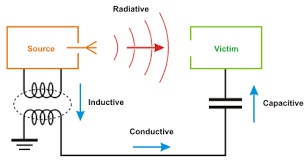When are differential pairs needed?
There are three reasons to use differential pairs in a digital or analog signal path.
Where the ground connections between the ends of the signal path are poor.
The most important one is that the ground connection between the two ends of the signal path can be very poor and data quality will not be compromised.Compare this to a single-ended signal path such as LVCMOS, where the signal arriving at the receiver is compared to a reference level in the receiver. If the grounds between the two ends are offset, the logic levels will be offset and one or the other of the two logic levels is compromised. This ability to “ignore” ground offsets has been the backbone of the wired Internet from the onset. In the case of Ethernet,the two ends of these links are transformer coupled.
Where there is significant attenuation along the signal path.
A second reason to use differential signaling is that the link can suffer substantial attenuation of the signal and still function properly.In the case of the old ECL differential signaling circuit
(the original differential protocol after which all later differential logic has been patterned),the signal leaving the driver is roughly 1000 mV. It only requires 20 mV for the receiver to successfully respond, so the signal could be attenuated as much as 24 db. In the case of many of the gigabit and higher differential signaling protocols currently in use, the signals can be attenuated as much as 20 db and the link still functions correctly.
When very high data rates are required.
A third reason to use differential pairs is for data paths with very high data rates such as gigabit and higher links. It is possible to drive differential paths at rates as high as 10 Gb/S over copper traces in standard PCB materials.This is impossible to do with single-ended logic
paths.
The first area where differential signaling was employed was the data paths between the various chassis in early mainframe computer systems. The protocol used was ECL differential signaling. Next, differential signaling was used for slow speed data links where the environment contained large amounts of electrical noise such as a factory floor. The usual protocol was RS-422 with very large signal swings.
Single-ended logic was successfully employed in almost all TTL and CMOS digital applications with wide parallel data buses until laptop computers came onto the scene with a large graphics data stream that had to pass from the motherboard through the hinge to the graphics display. When parallel data paths were used, two problems crept in: The wire bundle associated with the wide parallel data bus did not fit well into the hinge, and the ground connection was not satisfactory for single-ended operation as the simultaneous switching noise (SSN) was excessive. The solution was to switch to a serial data stream using differential signaling and call the protocol LVDS.
Since then, this protocol has been used in an increasingly wider array of products, giving rise to the following protocols. All of the following protocols share the same characteristics and
can use the same design rules:
All of the following protocols share the same characteristics and can use the same design rules:
• Infiniband
• Ethernet
• Hyper Transport
• PCI Express
• Fiberchannel
• XAUI
• Rocket I/O
• Firewire
• IEEE 1394
• Universal Serial Bus (USB)
• SSCSI (serial SCSI)
• SATA (serial ATA)
• SIDE (serial IDE)


Comments
Post a Comment